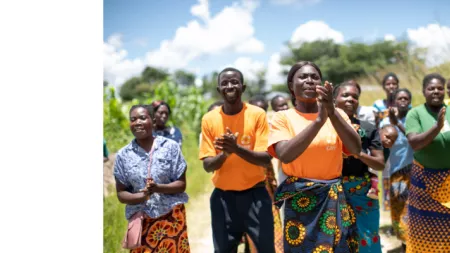Even in COVID-19, even in global food crisis, our impact continues to grow and help the world achieve the Sustainable Development Goals. To be painfully clear—this is in a year where the UN predicts that global progress towards almost every goal will go backwards. To take just one example, the UN predicts that COVID-19 will wipe out ALL of the progress out of poverty the world has made since 2015. At the same time, CARE and our partners have been able to measure impact for 10% of the people the UN estimates needs support in that goal.
The Sustainable Development Goals represent a collective, global commitment to a transforming the world for the better between 2015 and 2030. Actors like governments, the UN, and businesses have all made commitments to advancing the SDGs. It is only right that an organization like CARE also be accountable to demonstrating how its work contributes to these shared goals toward this collective vision.
Seeing the impact CARE and our partners have even in the face of massive global challenges is something to celebrate. As we continue to measure the longer-term impacts of our work with COVID-19 and addressing rapidly rising food crisis, we expect these numbers will continue to grow.
Between 2015 and 2021 CARE and our partners have contributed to global change for 161 million people in 83 countries. We use the word “contributions” deliberately: in all our work, change happens through the combined efforts of many different actors, including civil society and movements, governments, and the private sector. Our programs are just some of the contributing factors that lead to these impacts and outcomes.
CARE is the only organization that can track these impacts for the entire life of the SDGs, and CARE was the first INGO to be tracking our impacts against multiple SDGs. CARE has measured impacts in 13 out of 17 SDGs.
What do our impact numbers tell us about how CARE and our partners are contributing to global change?
- Ending Poverty: 73.9 million recieved quality humanitarian assistance, access to basic services, or to reduce poverty, in 56 countries. For example, 8.3m crisis-affected people in Yemen obtained cash, improved hygiene or access to clean water
- Zero Hunger: 22.6 million people to increased food security, or improved nutrition or sustainable agriculture, in 54 countries. For example, 1.6m people in Nepal improved their food security, through participatory social accountability.
- Good Health and Well-Being: supported 43.3 million women to exercise their right to sexual and reproductive health, in 44 countries. For example, 7.8m couples in Bangladesh got modern contraceptives from NGO service delivery partners.
- Quality Education: helped 4.4 million children to access better quality or more inclusive education services, in 30 countries. For example, 420,000 children in Timor-Leste have quality education materials to build literacy.
- Gender Equality: supported 13.8 million women and girls supported to increase their levels of empowerment and gender equality, in 70 countries. For example, CARE and our partners helped over 260,000 women in 5 countries reject intimate partner violence.
- Clean Water and Sanitation: 10.2 million people accessed clean water or improved sanitation services, in 31 countries. For example, 5.8m people in Peru got access to better water and sanitation services
- Decent Work and Economic Growth: 17.6 million people in 65 countries increased their economic empowerment and dignified work.
- Reduced Inequalities: 12.5 people from most excluded groups in 58 countries experienced reduced inequality. For example, the Domestic Workers’ program in Latin America helped 90,000 increase awareness of their rights
- Climate Action: 5.9 million people in 40 countries built climate resilience or reduced their vulnerabilities to climate shocks. For example, in Madagascar we contributed to increased resilience for 756,000 people
- Peace, Justice, and Strong Institutions: 4.5 million people in 47 countries increased their meaningful participation in decision-making. For example, in Ghana we helped increase meaningful participation in local government decision-making for 2.8m people
- Partnership for the goals. 57.9 million people in 54 countries have seen improvements in their lives because of 255 advocacy successes.
How did it happen?
- Build evidence for equality. Burundi’s Win-Win project showed that focusing on gender equality in agriculture increases in rice production, food security, and incomes, as well as feelings of safety and attitudes rejecting gender-based violence. The approach produced a return of $5 for every $1 invested, compared to a $3 return from a gender mainstreaming approach that just shared messages on gender equality.
- Support women leaders and organizers. Made by Women has enabled 217,000 women garment factory workers in Asia to claim their rights or reduce risk of sexual harassment in the workplace, and a further 4.1m stand to benefit from improved legal practices CARE and our partners have influenced. 300 factories have worked with CARE to make changes to their policies, systems, and workplace cultures.
- Get EVERYONE to fight gender based violence. With our local partners RWAMREC and RWN in the Indashyikirwa project in Rwanda, a couples’ curriculum program contributed to a 55% reduction in the odds of women experiencing physical and/or sexual intimate partner violence (IPV). Amongst men, the curriculum led to a 47% reduction in the odds of reporting having perpetrated physical and/or sexual IPV.
- Strengthen national systems. The Bihar health program in India has improved health services for 28.9m women and children, strengthening capacities of the Government health system. Use of modern contraceptives increased from 44.5% to 77.8%, and the proportion of births attended by skilled health personnel increased from 68.4% to 79.2%.
- Advocate for global systems change. CARE and allies successfully advocated for an additional $1bn in US Government global humanitarian funding for famine relief, providing assistance to 20-30m people a year starting in 2018.
Want to learn more?
Check out CARE’s 2022 report on the SDGs.
CARE has reached 73.9 million, and the UN estimates 731 million people in extreme poverty in 2021.
